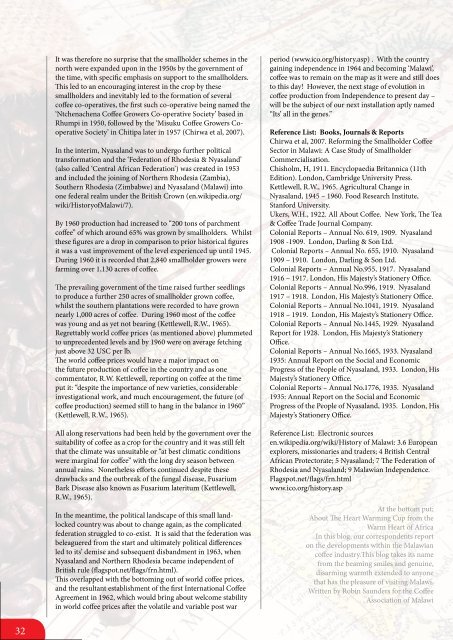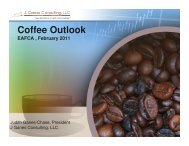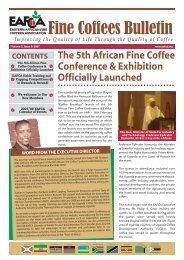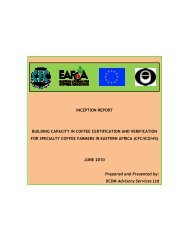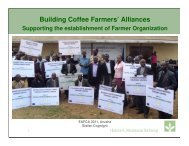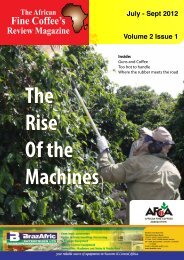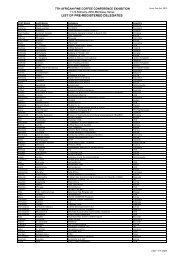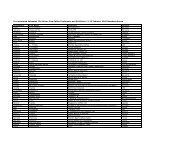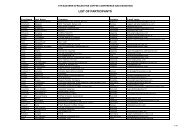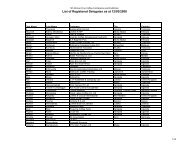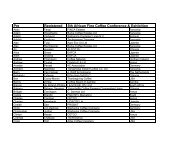African Fine Coffees Review Special Edition Oct-Dec - EAFCA
African Fine Coffees Review Special Edition Oct-Dec - EAFCA
African Fine Coffees Review Special Edition Oct-Dec - EAFCA
Create successful ePaper yourself
Turn your PDF publications into a flip-book with our unique Google optimized e-Paper software.
32<br />
It was therefore no surprise that the smallholder schemes in the<br />
north were expanded upon in the 1950s by the government of<br />
the time, with specific emphasis on support to the smallholders.<br />
This led to an encouraging interest in the crop by these<br />
smallholders and inevitably led to the formation of several<br />
coffee co-operatives, the first such co-operative being named the<br />
‘Ntchenachena Coffee Growers Co-operative Society’ based in<br />
Rhumpi in 1950, followed by the ‘Misuku Coffee Growers Cooperative<br />
Society’ in Chitipa later in 1957 (Chirwa et al, 2007).<br />
In the interim, Nyasaland was to undergo further political<br />
transformation and the ‘Federation of Rhodesia & Nyasaland’<br />
(also called ‘Central <strong>African</strong> Federation’) was created in 1953<br />
and included the joining of Northern Rhodesia (Zambia),<br />
Southern Rhodesia (Zimbabwe) and Nyasaland (Malawi) into<br />
one federal realm under the British Crown (en.wikipedia.org/<br />
wiki/HistoryofMalawi/7).<br />
By 1960 production had increased to “200 tons of parchment<br />
coffee” of which around 65% was grown by smallholders. Whilst<br />
these figures are a drop in comparison to prior historical figures<br />
it was a vast improvement of the level experienced up until 1945.<br />
During 1960 it is recorded that 2,840 smallholder growers were<br />
farming over 1,130 acres of coffee.<br />
The prevailing government of the time raised further seedlings<br />
to produce a further 250 acres of smallholder grown coffee,<br />
whilst the southern plantations were recorded to have grown<br />
nearly 1,000 acres of coffee. During 1960 most of the coffee<br />
was young and as yet not bearing (Kettlewell, R.W., 1965).<br />
Regrettably world coffee prices (as mentioned above) plummeted<br />
to unprecedented levels and by 1960 were on average fetching<br />
just above 32 USC per lb.<br />
The world coffee prices would have a major impact on<br />
the future production of coffee in the country and as one<br />
commentator, R.W. Kettlewell, reporting on coffee at the time<br />
put it: “despite the importance of new varieties, considerable<br />
investigational work, and much encouragement, the future (of<br />
coffee production) seemed still to hang in the balance in 1960”<br />
(Kettlewell, R.W., 1965).<br />
All along reservations had been held by the government over the<br />
suitability of coffee as a crop for the country and it was still felt<br />
that the climate was unsuitable or “at best climatic conditions<br />
were marginal for coffee” with the long dry season between<br />
annual rains. Nonetheless efforts continued despite these<br />
drawbacks and the outbreak of the fungal disease, Fusarium<br />
Bark Disease also known as Fusarium lateritum (Kettlewell,<br />
R.W., 1965).<br />
In the meantime, the political landscape of this small landlocked<br />
country was about to change again, as the complicated<br />
federation struggled to co-exist. It is said that the federation was<br />
beleaguered from the start and ultimately political differences<br />
led to its’ demise and subsequent disbandment in 1963, when<br />
Nyasaland and Northern Rhodesia became independent of<br />
British rule (flagspot.net/flags/frn.html).<br />
This overlapped with the bottoming out of world coffee prices,<br />
and the resultant establishment of the first International Coffee<br />
Agreement in 1962, which would bring about welcome stability<br />
in world coffee prices after the volatile and variable post war<br />
period (www.ico.org/history.asp) . With the country<br />
gaining independence in 1964 and becoming ‘Malawi’,<br />
coffee was to remain on the map as it were and still does<br />
to this day! However, the next stage of evolution in<br />
coffee production from Independence to present day –<br />
will be the subject of our next installation aptly named<br />
“Its’ all in the genes.”<br />
Reference List: Books, Journals & Reports<br />
Chirwa et al, 2007. Reforming the Smallholder Coffee<br />
Sector in Malawi: A Case Study of Smallholder<br />
Commercialisation.<br />
Chisholm, H, 1911. Encyclopaedia Britannica (11th<br />
<strong>Edition</strong>). London, Cambridge University Press.<br />
Kettlewell, R.W., 1965. Agricultural Change in<br />
Nyasaland, 1945 – 1960. Food Research Institute,<br />
Stanford University.<br />
Ukers, W.H., 1922. All About Coffee. New York, The Tea<br />
& Coffee Trade Journal Company.<br />
Colonial Reports – Annual No. 619, 1909. Nyasaland<br />
1908 -1909. London, Darling & Son Ltd.<br />
Colonial Reports – Annual No. 655, 1910. Nyasaland<br />
1909 – 1910. London, Darling & Son Ltd.<br />
Colonial Reports – Annual No.955, 1917. Nyasaland<br />
1916 – 1917. London, His Majesty’s Stationery Office.<br />
Colonial Reports – Annual No.996, 1919. Nyasaland<br />
1917 – 1918. London, His Majesty’s Stationery Office.<br />
Colonial Reports – Annual No.1041, 1919. Nyasaland<br />
1918 – 1919. London, His Majesty’s Stationery Office.<br />
Colonial Reports – Annual No.1445, 1929. Nyasaland<br />
Report for 1928. London, His Majesty’s Stationery<br />
Office.<br />
Colonial Reports – Annual No.1665, 1933. Nyasaland<br />
1935: Annual Report on the Social and Economic<br />
Progress of the People of Nyasaland, 1933. London, His<br />
Majesty’s Stationery Office.<br />
Colonial Reports – Annual No.1776, 1935. Nyasaland<br />
1935: Annual Report on the Social and Economic<br />
Progress of the People of Nyasaland, 1935. London, His<br />
Majesty’s Stationery Office.<br />
Reference List: Electronic sources<br />
en.wikipedia.org/wiki/History of Malawi: 3.6 European<br />
explorers, missionaries and traders; 4 British Central<br />
<strong>African</strong> Protectorate; 5 Nyasaland; 7 The Federation of<br />
Rhodesia and Nyasaland; 9 Malawian Independence.<br />
Flagspot.net/flags/frn.html<br />
www.ico.org/history.asp<br />
At the bottom put;<br />
About The Heart Warming Cup from the<br />
Warm Heart of Africa<br />
In this blog, our correspondents report<br />
on the developments within the Malawian<br />
coffee industry.This blog takes its name<br />
from the beaming smiles and genuine,<br />
disarming warmth extended to anyone<br />
that has the pleasure of visiting Malawi.<br />
Written by Robin Saunders for the Coffee<br />
Association of Malawi


